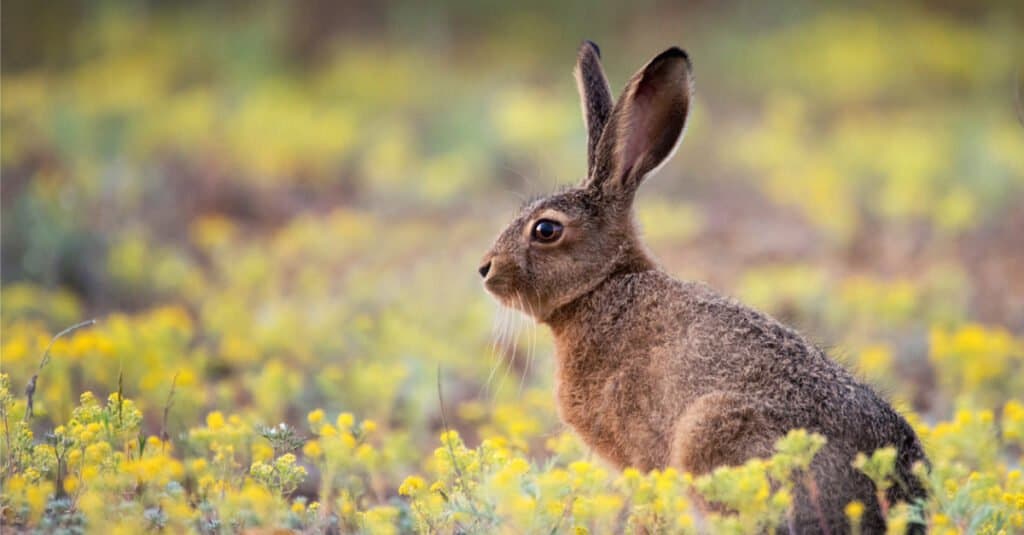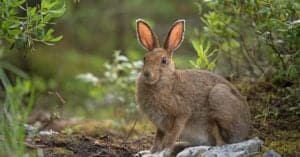Taking one look at their name, it’s easy to assume that jackrabbits are rabbits. It’s printed in their names after all. But in reality, jackrabbits are not actually rabbits, but hares. Hares are much bigger in size than the average rabbit. Unlike rabbits, it is possible for jackrabbits to grow up to two feet tall. There are both black-tailed and white-tailed jackrabbits that can be found in shrubs and grasslands.
Jackrabbits are exclusively plant eaters. They often eat over a pound of shrubs, grass, or tree bark in one day. So what foods exactly go with these hares’ primary diet? Below, we’ll take a look at what jackrabbits eat, who preys on them, how much they eat, and their relationship with humans.
What Do Jackrabbits Eat?

Jackrabbits eat a wide variety of plant species, including grasses, shrubs, flowers, and even small trees.
©Vincent Pro Photo/Shutterstock.com
Jackrabbits are herbivores that eat a diet of grass, shrubs, flowers, roots, and other plants.
As herbivores, jackrabbits exclusively eat plants, however with a range that extends across much of the Great Plains and into the Sonoran desert, jackrabbits are adaptable to local environments. Their primary diet includes:
- Grass
- Shrubs
- Tree bark
- Flowers
- Flowering plants
- Mesquite
- Cacti
- Small trees
- Roots
- Twigs
- Leaves
Their food depends on the season too, mostly due to the fact that particular plants are more scarce during the winter. It is also critical for jackrabbits to consume plants with high moisture levels, because they obtain most of their water through plant consumption.
How Do Jackrabbits Eat?
The black-tailed jackrabbit, a common type, feeds only on vegetation like grasses, mesquite, and cacti. The jackrabbit’s appendix is a pre-digesting chamber that starts to break down these food sources before they go down the stomach and get absorbed. When the jackrabbit is eating, it leaves clean diagonal cuts on the stalks of the plants it is feeding on. They have two rows of upper incisors, with small, secondary teeth that sit right next to the main incisors on each side of them.
Jackrabbits search for food in the morning and at night, resting and burrowing themselves, and depositing their scat in various places. Jackrabbits usually produce two droppings, the first one is a round ball that is soft, moist, and covered in mucous. They are high in protein and B vitamins made by bacteria in their intestines, so jackrabbits eat these droppings for additional nutrition. The waste products are dropped on the ground as a dry, powdery lump after going through the digestive system once again. Jackrabbits’ scat is made up of fibrous, compacted plant matter.
How Much Do Jackrabbits Eat?

Depending on their size, jackrabbits eat a pound of green foliage in a day.
©iStock.com/MriyaWildlife
A jackrabbit may be small compared to other mammals, but despite their size, they eat a lot. Jackrabbits eat green foliage between a half pound and a pound per day, depending on their size. As a result, large jackrabbit populations can cause significant harm to grasslands and other rangeland vegetation. It is estimated that eight jackrabbits can consume the same amount as one sheep, and 41 jackrabbits can eat as much as one cow.
What Animals Eat Jackrabbits?
Large mammals such as coyotes, foxes, bobcats, mountain lions, and weasels eat jackrabbits. To hunt jackrabbits, these predators will chase them down in open ground, make quick, sudden moves, and pounce.
Sharp senses, superb camouflage, and high running speeds are the only things that can protect jackrabbits from predators.
Jackrabbits have an incredible reproduction rate, making up to the large number of jackrabbits preyed upon by numerous predators in their environment. Black-tailed jackrabbits can produce up to six litters each year, with each litter containing as many as eight young jackrabbits or leverets, although two to four leverets occur more frequently in the wild. Their regular litters also serve as a form of protection against losing too many of their kind to carnivores.
How Do Jackrabbits Escape Predators?

Jackrabbits are agile and fast. They can jump 10 feet and run at 40 miles per hour.
©iStock.com/Byrdyak
Between four and eight pounds, the black-tailed jackrabbit is the size of a small dog. Female jackrabbits are also larger than the male. Jackrabbits grow between 18 and 26 inches long. Each of their tails has a black stripe that runs from the top to the rump that measures between 2 inches and 4 and a half inches long. The large ears of jackrabbits measure between 4 and 7 inches long.
Since jackrabbits have taller hind legs than rabbits, they can jump higher as well. In fact, way higher! These animals can hop five to ten feet high and can even reach 20 feet when threatened by a predator. Given their length and diameter, jackrabbits are also very fast runners. Remember the story about the tortoise and the hare? Now you’ll learn how much of an advantage the hare had in the story. Jackrabbits can run at an incredible speed of 40 miles per hour. This is how they avoid their predators too, leaping high and running fast in zigzag directions.
Are Jackrabbits Harmful for the Environment?
Jackrabbits are not exactly harmful for the environment, nor for humans. They, however, have an insatiable appetite when it comes to vegetation, which can be bad for farmers, as they often cause them trouble with their crops.
What Do Jackrabbits Eat as Pets?
While they may look similar to pet rabbits, jackrabbits are not as good as pets. They belong to the wild, and they require more intricate care than the average pet rabbits do.
When held captive inside zoos, jackrabbits require a lot of space as well as exercise. When in their natural habitat, they move at extremely high speeds and reside above the ground. This means that they require more space to run than they do for burrowing, as opposed to rabbits. Zookeepers can supplement their pelleted meals with hay, fresh greens, and the occasional piece of fruit as a special treat.
The photo featured at the top of this post is © iStock.com/Byrdyak
Thank you for reading! Have some feedback for us? Contact the AZ Animals editorial team.






